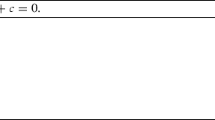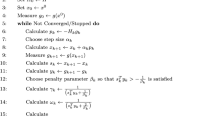Abstract
Quasi-Newton algorithms minimize a functionF(x),x ∈R n, searching at any iterationk along the directions k=−H kgk, whereg k=∇F(x k) andH k approximates in some sense the inverse Hessian ofF(x) atx k.
When the matrixH is updated according to the formulas in Broyden's family and when an exact line search is performed at any iteration, a compact algorithm (free from the Broyden's family parameter) can be conceived in terms of the followingn ×n matrix:
which can be viewed as an approximating reduced inverse Hessian.
In this paper, a new algorithm is proposed which uses at any iteration an (n−1)×(n−1) matrixK related toH R by
whereQ is a suitable orthogonaln×n matrix. The updating formula in terms of the matrixK incorporated in this algorithm is only moderately more complicated than the standard updating formulas for variable-metric methods, but, at the same time, it updates at any iteration a positive definite matrixK, instead of a singular matrixH R.
Other than the compactness with respect to the algorithms with updating formulas in Broyden's class, a further noticeable feature of the reduced Hessian algorithm is that the downhill condition can be stated in a simple way, and thus efficient line searches may be implemented.
Similar content being viewed by others
References
Fletcher, R.,On Newton's Method for Minimization, University of Dundee, Dundee, Scotland, Department of Mathematics, Report No. NA/19, 1976.
Fletcher, R.,The Reduced Hessian in Variable Metric Methods, Paper Presented at the University of Dundee Biennial Conference on Numerical Analysis, Dundee, Scotland, 1977.
Broyden, C. G.,Quasi-Newton Methods and Their Application to Function Minimization, Mathematics of Computation, Vol. 21, pp. 368–381, 1967.
Broyden, C. G.,The Convergence of a Class of Double-Rank Minimization Algorithms, Parts 1 and 2, Journal of the Institute of Mathematics and Its Applications, Vol. 6, pp. 76–90, 1970 and Vol. 6, pp. 222–231, 1970.
Fletcher, R.,A New Approach to Variable Metric Algorithms, Computer Journal, Vol. 13, pp. 317–322, 1970.
Goldfarb, D.,A Family of Variable Metric Methods Derived by Variational Means, Mathematics of Computation, Vol. 24, pp. 23–26, 1970.
Shanno, D. F.,Conditioning of Quasi-Newton Methods for Function Minimization, Mathematics of Computation, Vol. 24, pp. 647–657, 1970.
Dixon, L. C. W.,Quasi-Newton Algorithms Generate Identical Points, Mathematical Programming, Vol. 2, pp. 383–387, 1972.
Davidon, W. C.,Variable Metric Method for Minimization, Argonne National Laboratory, Argonne, Illinois, Report No. ANL-5990, 1959.
Fletcher, R., andPowell, M. J. D.,A Rapidly Convergent Descent Method for Minimization, Computer Journal, Vol. 6, pp. 163–168, 1963.
Author information
Authors and Affiliations
Additional information
Communicated by H. Y. Huang
This work was supported by the National Research Council of Italy under Grant No. 78.02386.07.
The author is grateful to R. Fletcher, Department of Mathematics, University of Dundee, Scotland, for his advices and suggestions which have proved most valuable in many ways.
Rights and permissions
About this article
Cite this article
Grandinetti, L. A compact updating formula for quasi-Newton minimization algorithms. J Optim Theory Appl 36, 477–494 (1982). https://doi.org/10.1007/BF00940543
Issue Date:
DOI: https://doi.org/10.1007/BF00940543




